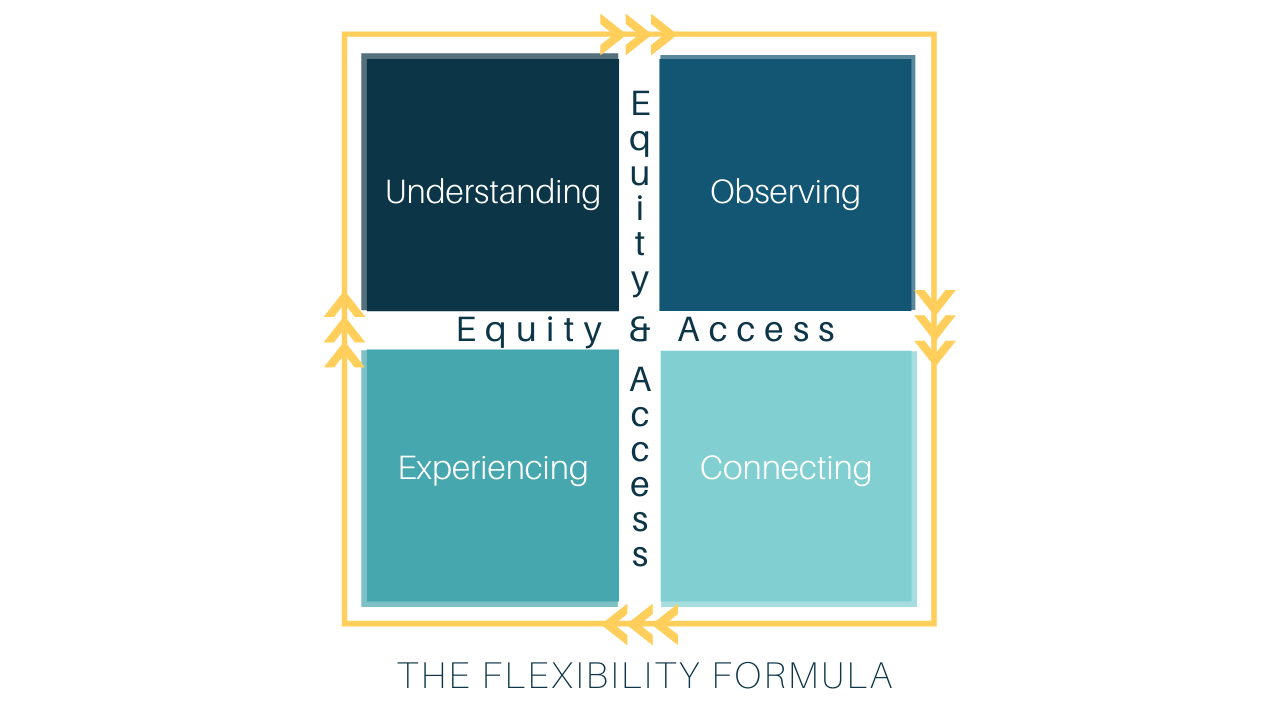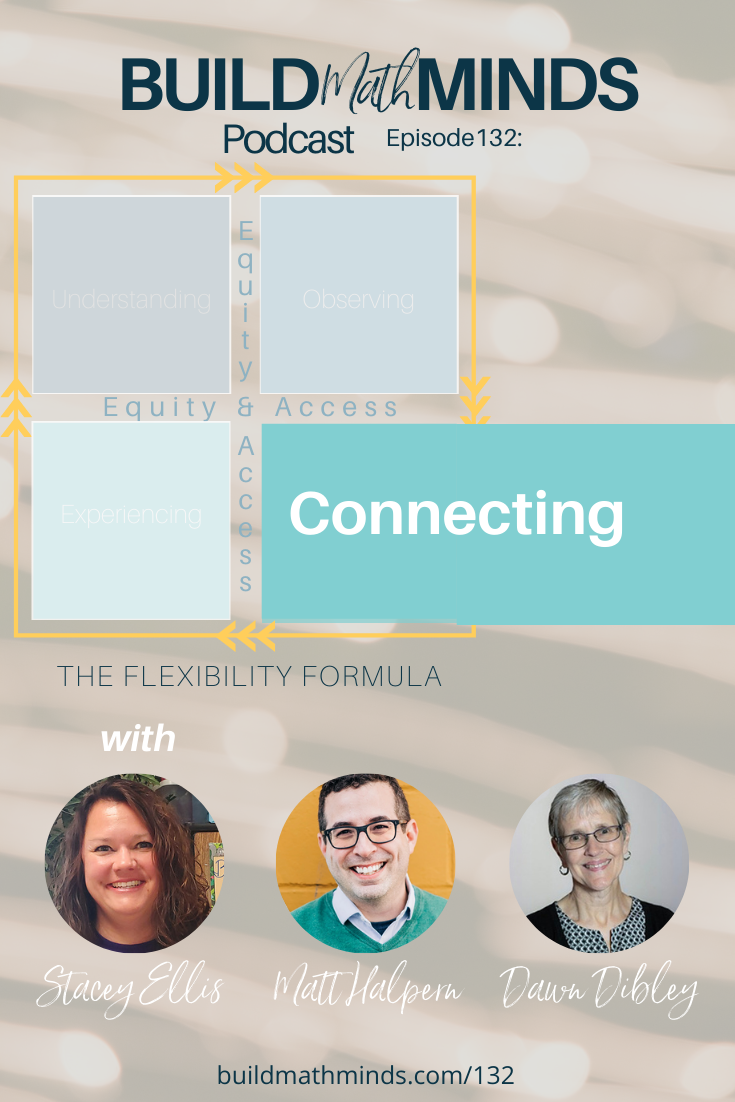Resources mentioned in this episode:
Welcome fellow Recovering Traditionalists to Episode 132. Today we are looking at sessions that help us with The Connecting Pillar with Stacey Ellis, Matt Halpern, & Dawn Dibley.
The 2022 Virtual Math Summit started yesterday, Feb 26 and the rest of the sessions are happening today. You have through March 8th to be able to watch the sessions at VirtualMathSummit.com after that they go into the Build Math Minds PD site for our members to have access to. So make sure you come watch and if you want to join the PD site so you get longer access, I’ll put a link to it on the show notes at buildmathminds.com/132.
I’ve been doing a series of episodes sharing some summit sessions that address each of The Flexibility Formula pillars of Equity & Access, Understanding, Observing, Connecting, and Experiencing. Episode 130 we took a look at Understanding, episode 131 we dove into Observing, and today’s episode we are going to look at Connecting.

Mathematics has traditionally been a subject that was taught as sets of isolated skills. BUT we are Recovering Traditionalists, and one big change we can make is to help kids see math as a connected web of understanding.
The connecting pillar is about helping kids see connections between the math content, but also about helping them see how math connects to their real life outside of school. In order to do that we need to find ways to connect with our students outside of the curriculum and outside of school.
There are a few sessions in this year’s Virtual Math Summit that give us ideas on how to build this Connecting pillar. Stacey Ellis, Matt Halpern, and Dawn Dibley’s sessions are some of them. In Stacey’s session, she is sharing how her 4th grade team connects real life math with school math by creating a microsociety where their students earn, spend, and lose money. Matt’s session reminds us that we have a relationship with all our students, whether we have taken the time to build it or not. He encourages us to make it a positive relationship by finding ways to connect with our students. In Dawn’s session, she gives us tips on how we can help students with disabilities develop understanding of Functional Mathematics they will need in their lives.
So, let’s dive in. Up first is a clip from Stacey Ellis’ session about the microsociety they create in 4th grade called Linderman Village.
Stacey: “So first let’s begin with what is Linderman Village? So Linderman Village is simply a micro society of fourth grade students and their teachers. At Linderman Elementary School, we have five 4th grade classrooms, teachers and paraprofessionals, which come to about 110 total people involved with our micro society. Each classroom is given its very own fun name. For instance, my classroom is Ellisville because my last name is Ellis. Another teacher at my school, her last name is Ayers, so she calls her class Ayers Valley. So it’s fun to come up with those catchy clever names. We all have street signs hanging outside our classrooms with our names on them so visitors to our school can find where we are quickly and efficiently.
So as I was saying, this is a micro society and it’s special because it encompasses so much of your classroom culture. For instance, our classroom rules and our management plan are interwoven into this micro society. Our classroom jobs are woven right into the society along with our reward system. There are so many benefits from Linderman Village. Down at the bottom of my screen, you can see that this society not only strengthens our values in our school, but it promotes cooperation and it gets kids learning about money and money management. And my favorite part is we get parents involved, we get families involved. And it is just a favorite, not only among our school, but people in the community are well aware of what we do with Linderman Village and are always willing to help and participate in any way they can. In fact, Linderman Village has been a part of Linderman Elementary School for over 20 years now. And each year we strive just to perfect it, make it better than the year before and our children really do benefit from this micro society.
So there’s three main parts. We have our classroom jobs and responsibilities. We have our classroom management plan and our reward system. And today I’m going to touch on each one of those with you.”
Next, let’s take a listen to a piece from Matt Halpern’s session about Tips & Strategies for Building Relationships:
Matt: “I love this idea of teaching from the heart. That children, what they want most of all is they want to be seen, and they want to be heard, and they need to feel they matter. And the best way for them to know that they matter is to tell them. It’s so important to tell kids, ‘I’m so glad you’re here today,’ or, ‘Oh my gosh. When you were out yesterday, we really missed you. The class isn’t the same when you’re not here.’ And let me tell you, for some kids, you’re like, ‘Oh my gosh. It was so much easier because they weren’t here.’ But you’re not going to tell them that. You’re going to tell them that you miss them, and that the class wasn’t the same without them because it wasn’t. So, you’re not lying.
And going along this idea of telling kids, I think that it’s important to use the word ‘love.’ And I know that people feel differently about this. But for me, I have always felt it’s super important that my students know that I love them, and so I tell them that I love them. Early in the year, I will have a conversation about the different types of love. And we’ll talk about romantic love. That’s when your mom and dad love each other, right? That’s different than familial love, or the love of family members. How you love your brothers, sisters, or how you love your pets. And then there’s friendship love. That friends can love each other, as well. And I tell them. I say, ‘That’s how I love you. I love you kind of like how you love your friends.’ And I want them to know it, plain and simple, that I love them. I just think that it’s critical that our kids know that.”
Our last clip for this week comes from Dawn Dibley’s session about Numeracy & Functional Mathematics:
Dawn: “Let’s start by clarifying my use of the terms numeracy and functional mathematics for our time together.
Numeracy refers to all the knowledge and skills necessary for us to understand mathematics. Knowing number word sequences forward and backward, the ability to identify numerals, and the ability to determine quantities and develop more sophisticated ways to determine and work with quantities using the operations of addition, subtraction, multiplication, and division with understanding. Understanding the relationships between numbers.
Functional mathematics, sometimes referred to as life skills mathematics, refers to the mathematics we use in everyday life. As a math coach for teachers who taught students with disabilities, I often heard statements like, ‘My students just need to know functional mathematics.’ Usually these teachers were referring to the topics of time and money. And I agree that these are important topics, and my concern is that we may not recognize the importance of a strong foundation of numeracy skills in developing these functional skills.
Students may reach a certain age and we decide it’s time for them to learn functional math skills, whether or not they have the prerequisite numeracy skills. We also need to consider the broader definition of functional math skills, which include skills that enable students to participate in their communities. These skills include recreational, domestic, and vocational activities. Functional mathematics aren’t just a concern for students with disabilities, but for all students who are transitioning to adulthood.
I appreciate the way that the ideas of functional mathematics and numeracy are combined in Australia. In 1997, the Australian Department of Employment, Education, Training and Youth Affairs stated ‘that to be numerate is to use mathematics effectively to meet the general demands of life at home, in paid work, and for participation in community and civic life.’
We also need to recognize that students are part of a community right now, and we can incorporate numeracy activities throughout their school day to make math meaningful and help students function in their school environment.
My goal is for all students to understand the mathematics they’re asked to engage with, and that includes what is commonly referred to as functional mathematics.”
Dawn’s session was released yesterday and Stacey & Matt’s sessions get released today (if you are listening to this on the day I released it, which is February 27th). Just come on over to VirtualMathSummit.com/schedule to watch the sessions. If you are listening to this after the summit, the sessions are available to watch for free through March 8th. After that, you can only watch them if you are a member of the Build Math Minds PD site. Not only do members get access to the 2022 Virtual Math Summit, but they also get access to the past 5 years of summit videos plus so many other elementary math PD trainings. You can get information about enrollment in the site at buildmathminds.com/bmm. If you don’t remember that URL, I’ll link everything up at the show notes page which is buildmathminds.com/132.
I hope this has helped you build your math mind so you can build the math minds of your students.
This episode is brought to you by the Build Math Minds professional development site. It’s an online site full of PD videos designed specifically for elementary teachers to help you build your math mind so you can build the math minds of your students. If you are interested in getting in-depth Math PD at Your Fingertips, become a member of Build Math Minds. Just go to buildmathminds.com/bmm and depending upon when you are listening to this, enrollment might be open or you can join the waitlist and get notified when it opens again.




